What Is Account-Based Marketing? Account-Based Marketing In A Nutshell
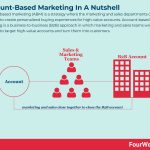

Account-based marketing (ABM) is a strategy where the marketing and sales departments come together to create personalized buying experiences for high-value accounts. Account-based marketing is a business-to-business (B2B) approach in which marketing and sales teams work together to target high-value accounts and turn them into customers.
Understanding account-based marketingAccount-based marketing is certainly not a new concept, though it has seen renewed interest in recent years. In the past, it was difficult to scale account-based marketing because it required a high level of personalization. Technological advancements have now made the ABM approach more accessible for businesses looking to develop highly targeted marketing content.
Essentially, the individual client account is considered a market in its own right, with each having a dedicated strategic approach to deepen the level of engagement across the entire marketing process.
In an era characterized by abundant information and fierce competition, it has never been more important for businesses to focus on accounts with the potential to deliver the highest return on investment.
Implementing account-based marketingFor most businesses, account-based marketing will feel like learning a new language. Instead of marketing to a demographic or buyer persona, the focus is on a specific organization.
Below we have listed some general steps to help businesses hit the ground running:
Define the strategic accounts – the business must begin by identifying the type of organization that will deliver the best ROI. This can be done by evaluating industry, company size, location, annual revenue, profit margin, or upsell potential. Investigate key stakeholders – with the strategic accounts identified, it is prudent to identify the key stakeholders in these organizations. Who are the key decision-makers? How are decisions made? LinkedIn can be a good source of information, as can any previous interactions with the organization.Create personalized content – as with traditional marketing strategies, the content should address specific pain points and detail how they can be addressed. Personalized content is fundamental to account-based marketing because the content needs to speak directly to the potential client.Decide on channels – where do the stakeholders spend their time? A marketing team targeting financial executives may choose to run ads on Bloomberg or Market Watch. Facebook and LinkedIn can also be good places to start because they allow the creation of targeted ad campaigns for specific organizations and the role titles within those organizations.Execute the campaign – when it comes time to run the marketing campaign, it is important to reiterate that the business is only marketing to a single client. Avoid bombarding them with messages across multiple channels in quick succession. Measure and share results – after one or two months have passed, it is time to evaluate the effectiveness of the marketing campaign. Was the content engaging? Were any of the leads moved further down the funnel? Was any revenue generated? Were there any areas for improvement?Benefits of account-based marketingBusinesses who are trying to sell into accounts with long sales cycles and large deal sizes will benefit the most from account-based marketing.
Here are some of the specific benefits they can enjoy:
Personalization – perhaps the most obvious benefit of account-based marketing is the degree of personalization offered to the client. Lucrative accounts attract a higher investment from marketing and sales, which deepens the relationship between the two parties.Shorter sales cycles – major purchase decisions can involve multiple stakeholders which slow the process down. In account-based management, these stakeholders are nurtured simultaneously to ensure a streamlined and more efficient sales cycle. What’s more, there are fewer steps in an ABM sales cycle when compared to traditional marketing.Increased collaboration – both sales and marketing teams work collaboratively to identify accounts, craft customized campaigns, and move accounts through the pipeline before and after lead conversion has occurred. The transparency of the ABM approach ensures both teams are focused on the same goals and understand the specific roles of each stakeholder. Key takeawaysAccount-based marketing (ABM) is a strategy where the marketing and sales departments come together to create personalized buying experiences for high-value accounts. Essentially, the individual client account is considered a market in its own right.Account-based marketing implementation can be performed by following six key steps: define strategic accounts, investigate key stakeholders, create personalized content, decide on channels, execute the campaign, and measure and share results. Teams should be careful not to bombard the client with similar marketing messages across multiple channels.Account-based marketing has multiple benefits, including a higher degree of personalization, shorter sales cycles, and increased collaboration between the sales and marketing departments.Other Types Of Marketing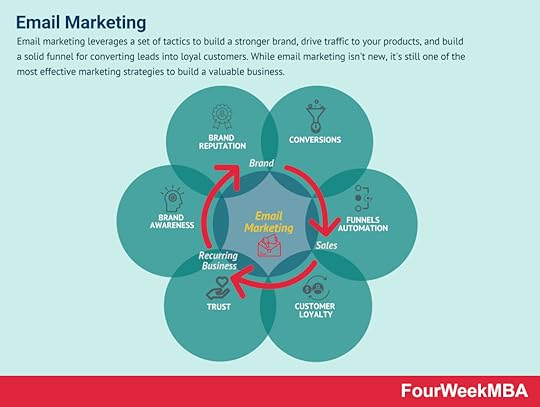 Email marketing leverages a set of tactics to build a stronger brand, drive traffic to your products, and build a solid funnel for converting leads into loyal customers. While email marketing isn’t new, it’s still one of the most effective marketing strategies to build a valuable business.
Email marketing leverages a set of tactics to build a stronger brand, drive traffic to your products, and build a solid funnel for converting leads into loyal customers. While email marketing isn’t new, it’s still one of the most effective marketing strategies to build a valuable business.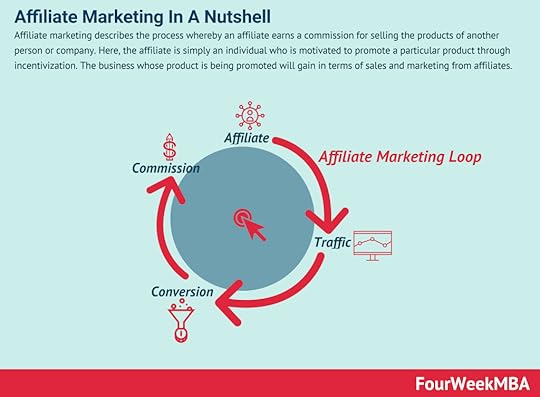 Affiliate marketing describes the process whereby an affiliate earns a commission for selling the products of another person or company. Here, the affiliate is simply an individual who is motivated to promote a particular product through incentivization. The business whose product is being promoted will gain in terms of sales and marketing from affiliates.
Affiliate marketing describes the process whereby an affiliate earns a commission for selling the products of another person or company. Here, the affiliate is simply an individual who is motivated to promote a particular product through incentivization. The business whose product is being promoted will gain in terms of sales and marketing from affiliates.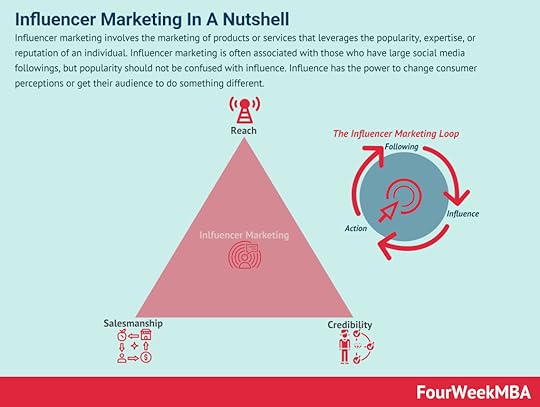 Influencer marketing involves the marketing of products or services that leverages the popularity, expertise, or reputation of an individual. Influencer marketing is often associated with those who have large social media followings, but popularity should not be confused with influence. Influence has the power to change consumer perceptions or get their audience to do something different.
Influencer marketing involves the marketing of products or services that leverages the popularity, expertise, or reputation of an individual. Influencer marketing is often associated with those who have large social media followings, but popularity should not be confused with influence. Influence has the power to change consumer perceptions or get their audience to do something different.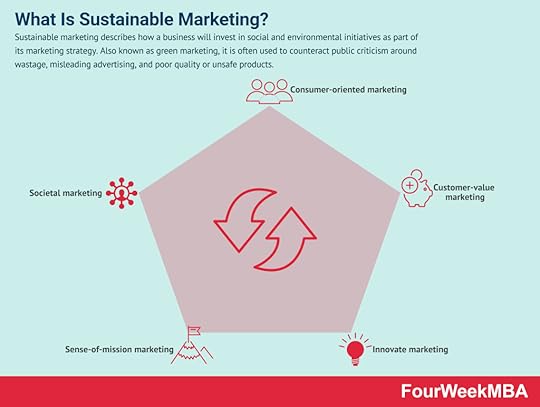 Sustainable marketing describes how a business will invest in social and environmental initiatives as part of its marketing strategy. Also known as green marketing, it is often used to counteract public criticism around wastage, misleading advertising, and poor quality or unsafe products.
Sustainable marketing describes how a business will invest in social and environmental initiatives as part of its marketing strategy. Also known as green marketing, it is often used to counteract public criticism around wastage, misleading advertising, and poor quality or unsafe products.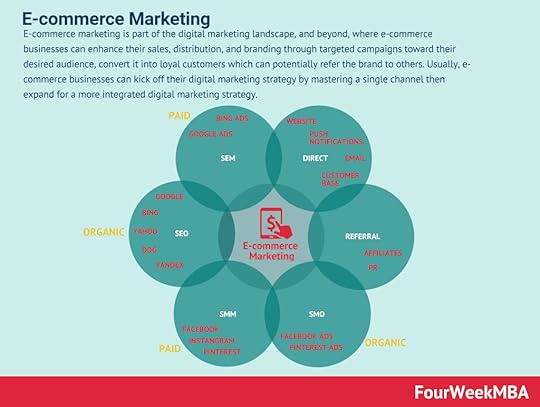 E-commerce marketing is part of the digital marketing landscape, and beyond, where e-commerce businesses can enhance their sales, distribution, and branding through targeted campaigns toward their desired audience, convert it into loyal customers which can potentially refer the brand to others. Usually, e-commerce businesses can kick off their digital marketing strategy by mastering a single channel then expand for a more integrated digital marketing strategy.
E-commerce marketing is part of the digital marketing landscape, and beyond, where e-commerce businesses can enhance their sales, distribution, and branding through targeted campaigns toward their desired audience, convert it into loyal customers which can potentially refer the brand to others. Usually, e-commerce businesses can kick off their digital marketing strategy by mastering a single channel then expand for a more integrated digital marketing strategy.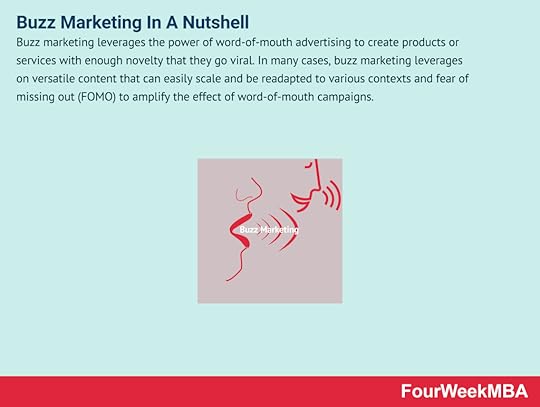 Buzz marketing leverages the power of word-of-mouth advertising to create products or services with enough novelty that they go viral. In many cases, buzz marketing leverages on versatile content that can easily scale and be readapted to various contexts and fear of missing out (FOMO) to amplify the effect of word-of-mouth campaigns.
Buzz marketing leverages the power of word-of-mouth advertising to create products or services with enough novelty that they go viral. In many cases, buzz marketing leverages on versatile content that can easily scale and be readapted to various contexts and fear of missing out (FOMO) to amplify the effect of word-of-mouth campaigns.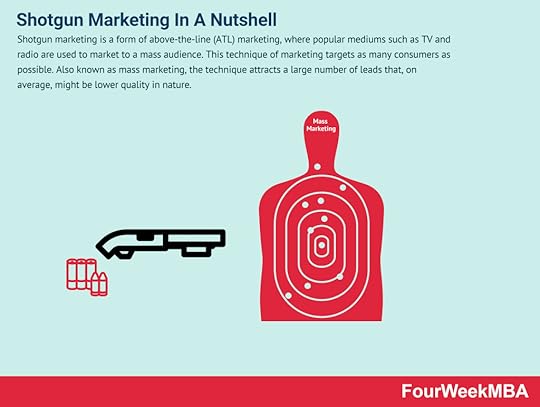 Shotgun marketing is a form of above-the-line (ATL) marketing, where popular mediums such as TV and radio are used to market to a mass audience. This technique of marketing targets as many consumers as possible. Also known as mass marketing, the technique attracts a large number of leads that, on average, might be of lower quality in nature.
Shotgun marketing is a form of above-the-line (ATL) marketing, where popular mediums such as TV and radio are used to market to a mass audience. This technique of marketing targets as many consumers as possible. Also known as mass marketing, the technique attracts a large number of leads that, on average, might be of lower quality in nature.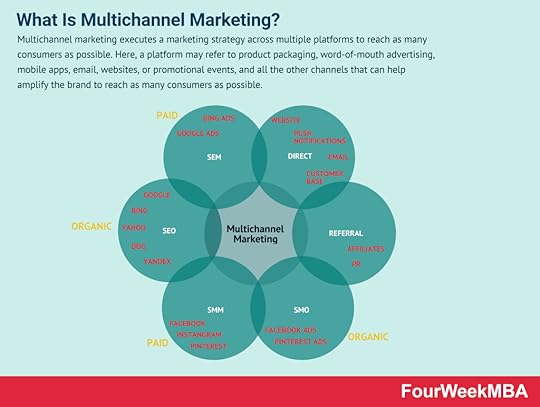 Multichannel marketing executes a marketing strategy across multiple platforms to reach as many consumers as possible. Here, a platform may refer to product packaging, word-of-mouth advertising, mobile apps, email, websites, or promotional events, and all the other channels that can help amplify the brand to reach as many consumers as possible.
Multichannel marketing executes a marketing strategy across multiple platforms to reach as many consumers as possible. Here, a platform may refer to product packaging, word-of-mouth advertising, mobile apps, email, websites, or promotional events, and all the other channels that can help amplify the brand to reach as many consumers as possible.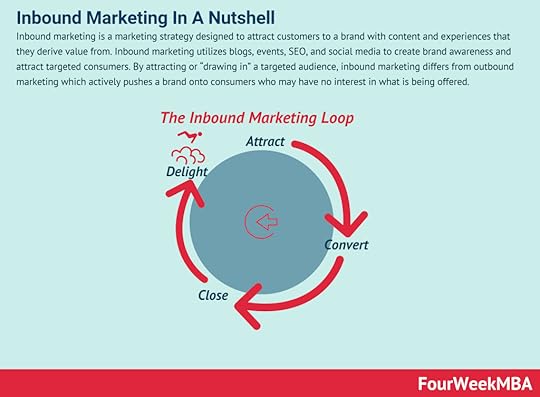 Inbound marketing is a marketing strategy designed to attract customers to a brand with content and experiences that they derive value from. Inbound marketing utilizes blogs, events, SEO, and social media to create brand awareness and attract targeted consumers. By attracting or “drawing in” a targeted audience, inbound marketing differs from outbound marketing which actively pushes a brand onto consumers who may have no interest in what is being offered.
Inbound marketing is a marketing strategy designed to attract customers to a brand with content and experiences that they derive value from. Inbound marketing utilizes blogs, events, SEO, and social media to create brand awareness and attract targeted consumers. By attracting or “drawing in” a targeted audience, inbound marketing differs from outbound marketing which actively pushes a brand onto consumers who may have no interest in what is being offered. With partnership marketing, two or more companies team up to create marketing campaigns that help them grow organically with a mutual agreement, thus making it possible to reach shared business goals. Partnership marketing leverages time and resources of partners that help them expand their market.
With partnership marketing, two or more companies team up to create marketing campaigns that help them grow organically with a mutual agreement, thus making it possible to reach shared business goals. Partnership marketing leverages time and resources of partners that help them expand their market.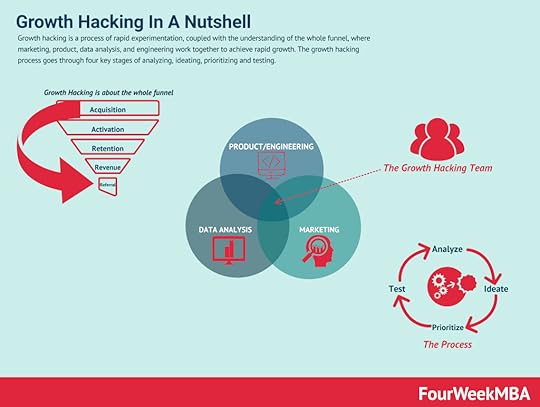 Growth marketing is a process of rapid experimentation, which in a way has to be “scientific” by keeping in mind that it is used by startups to grow, quickly. Thus, the “scientific” here is not meant in the academic sense. Growth marketing is expected to unlock growth, quickly and with an often limited budget.
Growth marketing is a process of rapid experimentation, which in a way has to be “scientific” by keeping in mind that it is used by startups to grow, quickly. Thus, the “scientific” here is not meant in the academic sense. Growth marketing is expected to unlock growth, quickly and with an often limited budget.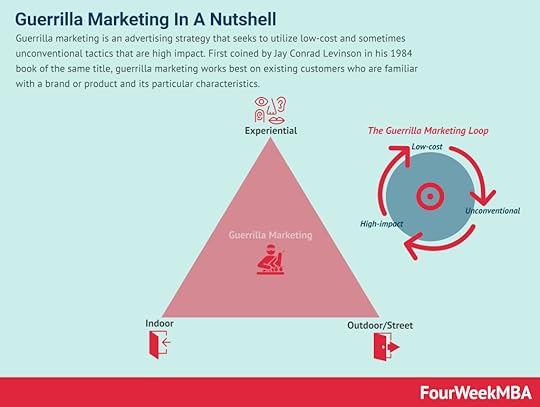 Guerrilla marketing is an advertising strategy that seeks to utilize low-cost and sometimes unconventional tactics that are high impact. First coined by Jay Conrad Levinson in his 1984 book of the same title, guerrilla marketing works best on existing customers who are familiar with a brand or product and its particular characteristics.
Guerrilla marketing is an advertising strategy that seeks to utilize low-cost and sometimes unconventional tactics that are high impact. First coined by Jay Conrad Levinson in his 1984 book of the same title, guerrilla marketing works best on existing customers who are familiar with a brand or product and its particular characteristics.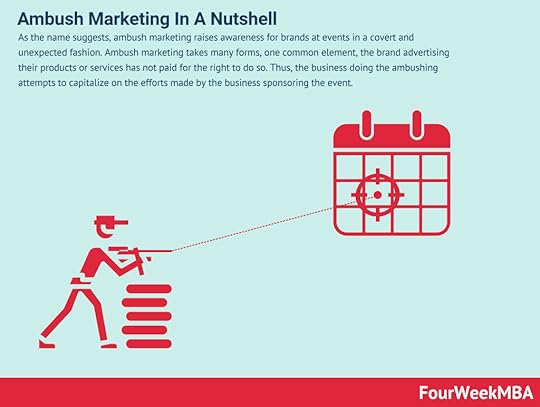 As the name suggests, ambush marketing raises awareness for brands at events in a covert and unexpected fashion. Ambush marketing takes many forms, one common element, the brand advertising their products or services has not paid for the right to do so. Thus, the business doing the ambushing attempts to capitalize on the efforts made by the business sponsoring the event.
As the name suggests, ambush marketing raises awareness for brands at events in a covert and unexpected fashion. Ambush marketing takes many forms, one common element, the brand advertising their products or services has not paid for the right to do so. Thus, the business doing the ambushing attempts to capitalize on the efforts made by the business sponsoring the event. Relationship marketing involves businesses and their brands forming long-term relationships with customers. The focus of relationship marketing is to increase customer loyalty and engagement through high-quality products and services. It differs from short-term processes focused solely on customer acquisition and individual sales.
Relationship marketing involves businesses and their brands forming long-term relationships with customers. The focus of relationship marketing is to increase customer loyalty and engagement through high-quality products and services. It differs from short-term processes focused solely on customer acquisition and individual sales.Main Free Guides:
Business ModelsBusiness CompetitionBusiness StrategyBusiness DevelopmentDigital Business ModelsDistribution ChannelsMarketing StrategyPlatform Business ModelsRevenue ModelsTech Business ModelsBlockchain Business Models FrameworkThe post What Is Account-Based Marketing? Account-Based Marketing In A Nutshell appeared first on FourWeekMBA.



